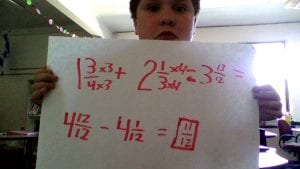Today in math we continued to work on solving word problems with fractions. When solving word problems we need to draw a visual to represent the problem, write an equation(s) with a variable to represent the unknown amount, show our work, and write the answer with a label. Shown below is what this looks like based on the following word problem:
“Rex is making bread. He combines 1 3/4 cups of white flour and 2 1/3 cups of wheat flour. He adds rye flour to make a total of 5 cups. How much rye flour does he add?”
1) Here is a picture of the work I did to solve the problem:

2) My answer and label is…
11/12 of rye flour
3) Why does drawing a visual help when solving a word problem?
It allows them to think while also looking at what is in front of them.
4) How are you feeling about solving word problems with fractions? Is there anything that you still need help with or need to work on further?
No, Ihighly dislike math i have always felt this twords math.
5) We have our Unit 1 test this Friday. Is there anything that you do not understand or want more help with?
No, I feel good about everything.

